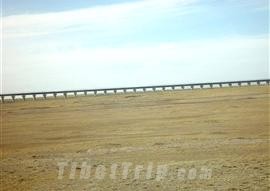 The Qinghai-Tibet railway is the longest and highest plateau based railroad in the world, with a total length of 1,956 kilometers (1,215 miles) connecting Xining in Qinghai Province and Lhasa in the Tibet Autonomous Region. The 1 st phase of the project from Xining to Golmud opened in 1984; Due to the altitude and geological conditions, deferred construction of the 2nd phase from Golmud to Lhasa started in 2001, with the completed railway officially opened by President Hu Jintao on July 1, 2006.
The Qinghai-Tibet railway is the longest and highest plateau based railroad in the world, with a total length of 1,956 kilometers (1,215 miles) connecting Xining in Qinghai Province and Lhasa in the Tibet Autonomous Region. The 1 st phase of the project from Xining to Golmud opened in 1984; Due to the altitude and geological conditions, deferred construction of the 2nd phase from Golmud to Lhasa started in 2001, with the completed railway officially opened by President Hu Jintao on July 1, 2006.The Tibet Railway refers to the section from Golmud to Lhasa and runs for 1,142 kilometers ( 710 miles ) through deserts, moors, marshes on the icy plateau itself, known as 'the roof of the world'. More than 80% of the lines construction is at an altitude in excess of 4,000 meters ( 1,312 feet ) with nearly a half of its length on the permafrost. As such, the railway is recognized as a groundbreaking feat of engineering that rivals the awe, magnificence, and wonder of the Great Wall itself. This railway brings an end to the page in history that Tibet has no railway. Hence, the 'Roof of the World' has become more widely accessible to travelers, allowing more people to probe into the wild interior of mythical land.
You may say: I would rather go to Tibet by air after the wearying journey to China ; why should I bother going by train? You are only partially right. Along the Tibet Railway, you will see the grandest and most mystical region of the entire world. It includes rivers, lakes, icy mountains, unbelievable grassland, holly valleys, and Kekexili- an uninhabited zone. The railway itself with 675 bridges is marvel to behold. It includes the longest bridge, Qingshuihe Bridge, the longest tunnel under permafrost on the plateau, Mt. Kunlun Tunnel, the highest railway station, Tanggula Railway Station and the highest tunnel, Fenghuoshan Tunnel.
The Tibet train from Golmud to Lhasa is equipped with the advanced appliance. There are forty-five stations in all. Thirty-seven stations used as rest stops and neither pick up, nor drop off passengers. Passengers can get on or get off the train at the other eight stations. Among the forty-five stations, nine stations are sightseeing stations. As the names of the stations suggest, the train stops at the nine stations for the passengers to have short sightseeing opportunities. The train to Tibet is to be divided into two types of services, passenger, and sightseeing. The later will stop at scenic spots stations, permitting visitors to get off, take photographs and look around for a period.








